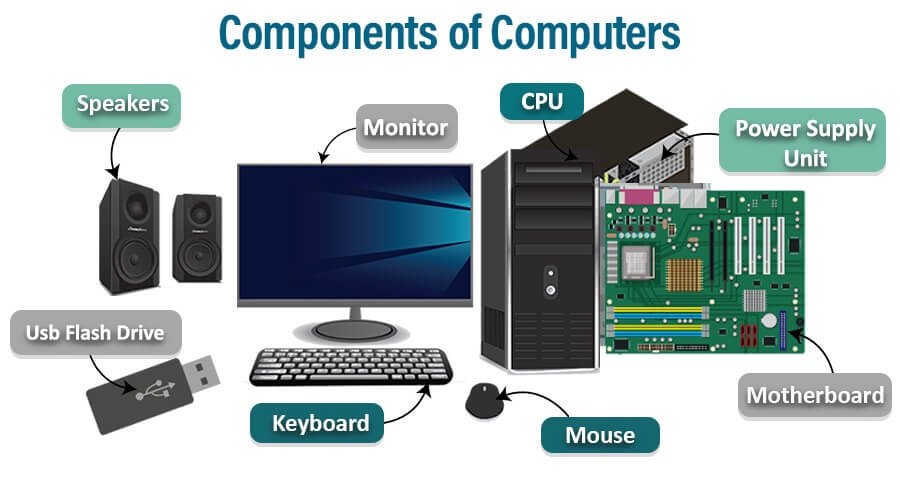Components Of A Computer
Category: COMPUTER SCIENCE | 12th March 2024, Tuesday

Computers Are Complex Systems Composed Of Various Hardware And Software Components That Work Together To Process Data And Perform Tasks.
Here Are The Key Components Of A Computer:
-
Central Processing Unit (CPU):
- The CPU Is The "brain" Of The Computer Responsible For Executing Instructions And Performing Calculations.
- It Consists Of The Control Unit, Arithmetic Logic Unit (ALU), And Registers.
- The Control Unit Coordinates The Execution Of Instructions, While The ALU Performs Arithmetic And Logic Operations.
-
Memory:
- Random Access Memory (RAM) Provides Temporary Storage For Data And Instructions That The CPU Needs To Access Quickly.
- Read-Only Memory (ROM) Contains Essential Startup Instructions And Firmware.
- Cache Memory Stores Frequently Accessed Data To Speed Up Processing.
-
Storage Devices:
- Hard Disk Drives (HDDs) And Solid-State Drives (SSDs) Store Data Persistently.
- Optical Drives, Such As CD/DVD Drives, Read And Write Data To Optical Discs.
- Flash Drives And Memory Cards Offer Portable Storage For Data Transfer.
-
Motherboard:
- The Motherboard Is A Large Circuit Board That Houses And Connects Various Components, Including The CPU, Memory, Storage Devices, And Expansion Cards.
- It Contains Slots, Connectors, And Buses For Communication Between Components.
-
Input Devices:
- Keyboards, Mice, Touchpads, And Touchscreens Allow Users To Input Commands And Data Into The Computer.
- Other Input Devices Include Scanners, Cameras, Microphones, And Sensors For Capturing Different Types Of Data.
-
Output Devices:
- Monitors, Printers, Speakers, And Displays Present Information Or Results To The User.
- Output Devices Convert Digital Signals Generated By The Computer Into Human-readable Formats.
-
Graphics Processing Unit (GPU):
- GPUs Are Specialized Processors Designed To Handle Graphics-related Tasks, Such As Rendering Images, Videos, And Animations.
- They Are Essential For Gaming, Multimedia Applications, And Graphical User Interfaces.
-
Expansion Cards:
- Expansion Cards, Also Known As Adapter Cards Or Interface Cards, Add Additional Functionality To The Computer.
- Examples Include Graphics Cards, Network Interface Cards (NICs), Sound Cards, And USB Expansion Cards.
-
Power Supply Unit (PSU):
- The PSU Converts Electrical Power From An Outlet Into Usable Voltages For The Computer's Components.
- It Supplies Power To The Motherboard, CPU, Storage Devices, And Other Peripherals.
-
Cooling System:
- Cooling Systems, Including Fans, Heat Sinks, And Liquid Cooling Solutions, Prevent Components From Overheating.
- They Dissipate Heat Generated By The CPU, GPU, And Other High-performance Components.
-
Operating System (OS):
- The OS Is System Software That Manages Hardware Resources, Provides User Interfaces, And Runs Applications.
- Examples Include Windows, MacOS, Linux, IOS, And Android.
-
Software Applications:
- Applications Are Programs Or Software Packages That Perform Specific Tasks Or Functions.
- Examples Include Web Browsers, Word Processors, Spreadsheets, Games, And Multimedia Players.
These Components Work Together Seamlessly To Enable The Computer To Process Data, Execute Instructions, And Perform Various Tasks Efficiently. Each Component Plays A Crucial Role In The Overall Functionality And Performance Of The Computer System.
Tags:
Components Of A Computer, Computer's Components
